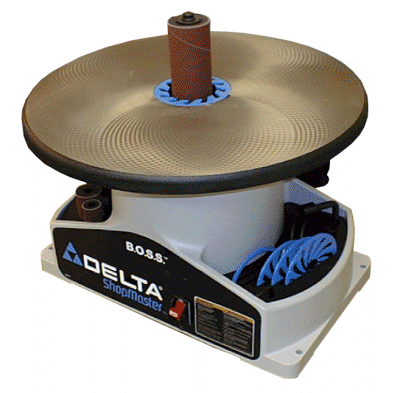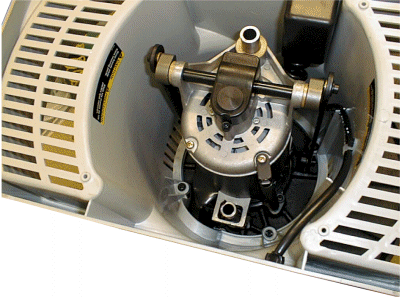|
|
|
 |
Description The Delta Boss sa350k is a benchtop, oscillating spindle sander. This particular version also includes several drums of different diameters. The Boss is powered by a 1/4hp induction motor housed in a large plastic base with on-board storage for extra drums, inserts, and a wrench. A mechanism powered by the motor in the base moves the spindle 7/8" at 60 strokes per minute. The fixed table is a large 18 diameter cast iron affair milled (not ground) flat with a central hole for the spindle. The Boss also has an integral dust collection system that is supposed to expel the dust into a bag on the back of the machine. |
| Up
and Down A sanding drum is a common woodworking tool typically used in a drill press. They are notorious for being less than perfectly round which causes vibration and for acquiring burn bands because in use, they are often sanding on the exact same spot on the drum all the time. An oscillating drum sander overcomes this last problem by moving the drum up and down as it rotates. Not only does this tend to solve the burn problem, the drums lasts longer and the finish is at least twice as good as what you can expect from a drum in a drill press. |
|
| In Use Although the Boss is not exactly small, it is small enough to stow away when it is not needed, light enough to pick up (fairly) easily, but still heavy enough not to get pushed off the bench when used. One must expect that the drums are not going to be perfectly straight, they are after all rubber and they are compressed some in order to keep the sanding sleeve on. It seems that the bow is fairly slight, you have to really be looking for it to notice this and that the sanded edges are not perfectly straight. The spindle on my unit was not perfectly 90 degrees to the table either. Fortunately the table can be shimmed if it is found to be unacceptably far off. |
 Under the Hood |
| The motor is rather
small but as long as you aren't trying to hog off material, it is adequate. I
haven't been able to stall the motor but I don't usually remove much material with it
either, it seems clear to me that this is its intended duty. Although it seems like the integral dust collection system would work well, I've found it to be somewhat unimpressive. I've been using a small shop vacuum with it and with this attached, dust collection is quite good. Although one could, I wouldn't recommend operating the Boss without an active pickup. Some users have complained that the 1.5" dust port is too small; it is for a typical 2" shop-vac hose. If this is what you intend to use, you'll need an adapter or some ingenuity to overcome this. I've read several complaints about changing the drums and that the unit should have a spindle lock. In my use, I've had absolute zero problems in this regard so I'm not sure exactly where these complaints are coming from. I employ the standard trick of applying a little talcum powder to a drum before tightening a sleeve down. I've had no problems removing sleeves on the Boss though. |
|
| Summary The Boss can be expensive to operate due to the price of the sanding sleeves. The best place I've found to buy sleeves is Klingspor's (18pc kit for $19.95). Six sleeves from the usual vendors will cost anywhere from $12 to $18 which is exorbitant. The Boss isn't the best sander of this type, the table doesn't tilt and the motor is not all powerful; it does however have redeeming qualities. It is stable, small, and does a pretty decent job of sanding. My unit came from a local big box, it included the extra sanding spindles but that is not always the case with this machine. As an accessory, the extra spindles cost about $60 which is high considering the cost of the machine itself with only one spindle. If the Boss is at the top of your oscillating sander list, search for a vendor offering the extra sleeve kit, this makes the critical difference on the value as a whole. |